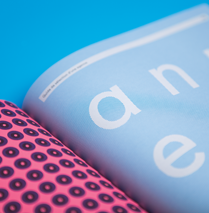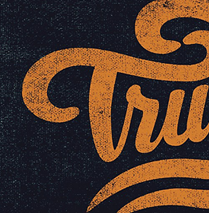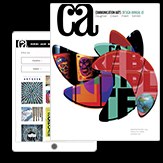How did you discover your passion for advertising and design, and where did you learn the tools to get started in the creative field? I grew up outside of New York City. My father was in fashion, and my mother was an opera singer. I was given unique opportunities to be around many movers and shakers across multiple industries, and when I was lucky enough to be a plus-one at my dad’s office on some summer days, I wanted nothing more than to be a fly on the wall in the fashion designers’ meetings. In turn, those led to meetings with big PR folks and advertising agencies. Not a designer or a copywriter, I wondered how to be a part of that and realized that project management and account executive territory could be amazing. My high school required an internship during senior year, and I gained experience at an ad agency that specialized in luxury jewelry—i.e., Chopard, Mikimoto and Tiffany & Co., among others. My freshman year in college, I knew I wanted to graduate with a double major in advertising and PR. I feel beyond fortunate that I entered the game when I did; digital was nonexistent, but I was at a place in my career to recognize the shift, pivot and learn it, knowing I’d be left behind otherwise.
My first job was as an account executive (AE) at a top agency in the Washington, DC, metro area. There were many AEs at this agency, and we were all hungry for opportunity and trying to figure out the real world. All of us were fiercely type A, driving our twenties in a fast-paced environment and managing clients who were picky about their specific point of contacts. A client of mine from Ryan Homes took me under his wing and nurtured me in the manner he wanted his top AE to perform and, in turn, learn. He was a tough cookie, but it worked. More than 25 years later, he’s still a mentor and one of my biggest cheerleaders.
I needed that push, so I leaned in and was intent on being the last to leave. I also made lifelong friends in an environment that was fiercely competitive, as we all realized those who were committed to the agency were being afforded more opportunities for growth. For me, that was easy. I’ve loved advertising and design since before I knew what they were. I’m a visual thinker. Thinking, strategy with intention and landing the plane are my specialties, and once I’m in my element, there’s no stopping me.
What led you to establish Red Thinking, your branding and digital creative agency? I had incredible agency opportunities and worked with some of the best. Throughout my successes, one thing kept happening—we were losing designers and writers to freelance, as it afforded them more control of their “destiny.” As freelancers, they could come in less in cost; however, the more I spoke to past employees that went out on their own, they couldn’t stand the money management aspect of it all. So, my thought was: Is there a way to have a remote agency? One where we came together naturally for collaborations and in-person meetings and then could be on the road to meet our clients at their offices? It used to be that clients wanted to come to the big, fancy, “Mad Men-esque” agency office because it was fun—think martinis, strategy and more. But successfully managing a work-life balance was becoming more popular. So, if I could lose the commute element and the cube nightmare where employees felt constantly watched, and I could find the right people—as not everyone is made to manage themselves from home—in return, they wouldn’t have to source work and manage the financials of it all, fearful of sending an estimate and being denied.
I was introduced to someone else that thought this same way and, at the time, was running what I envisioned almost as a manager of freelancers. We came together and launched a true-to-form agency that was immediately competitive to the brick-and-mortar agencies, as we are experienced, talented, strategic and creative industry professionals. The process of creating a company in this way was such a gift to have, as we were set up and ready to roll. I can honestly say I’ve never been happier in my career. My team is comprised of excellent and incredible human beings who continue to create and deliver.
Red Thinking has evolved over the years and ranks in the top 20 agencies across the Washington, DC, metro area annually, both from financials and overall client roster. We call some of the biggest organizations our clients and our friends. I love what I do so much, it’s a natural assumption our clients become our friends. We’re transparent, honest, and very good at what we do. I oversee all new business and sales, and our process to onboard is a fine-tuned machine.
An account that Red Thinking has had for a while now is with the National Crime Prevention Council and McGruff the Crime Dog. How has it been to work on this account, and what has it been like raising awareness of fentanyl on the client’s digital platforms? Working with the National Crime Prevention Council (NCPC) and McGruff the Crime Dog has been a deeply rewarding experience for Red Thinking. Given the severity of the fentanyl crisis, our collaboration focuses on a critical public health and safety issue that affects individuals from all walks of life, regardless of their background, upbringing or socioeconomic status. The executive director of NCPC came to us and said, “I envision a digital quilt, similar to the 1987 AIDS quilt in DC.” Of course, I remember it well. I realized we needed to nail this new campaign, as it would further educate people of all ages on the fentanyl crisis. The Lives Project (livesproject.org) also allows for the option to leave notes of remembrance and love as an outlet. It opens everyone’s eyes to how horrible the fentanyl crisis is as it’s in all of our own backyards. The ubiquity and danger of fentanyl make it a universal threat, and this has informed our approach to raising awareness on the NCPC’s digital platforms. Our strategies have been inclusive and far-reaching, emphasizing that no one is immune to this crisis. The goal has been to communicate effectively that the threat of fentanyl is real and pervasive and ignoring it is not an option.
Additionally, we are focusing on the NCPC’s Go For Real campaign, an initiative aimed at raising awareness about the dangers and consequences of purchasing counterfeit goods. This campaign is part of NCPC’s broader efforts to educate the public, particularly young consumers, about the risks associated with counterfeit products, which include potential harm to health and safety, economic losses, and the funding of criminal activities.
Key elements of the Go For Real digital campaign include:
- Information on how to identify counterfeit goods and the negative impacts of buying fake products.
- Focusing on younger consumers who might be more inclined to purchase counterfeit items, often through online platforms.
- Utilizing social media, videos, and other digital tools to reach a broad audience and engage them with interactive content and educational resources.
- The legal implications of buying and selling counterfeit goods and the potential health and safety risks they pose.
Through these efforts, the Go For Real campaign seeks to foster a more informed public that makes safer and more ethical purchasing decisions.
In creating content for the NCPC’s digital channels, we’ve prioritized clear, compelling and factual messaging. By leveraging social media, educational videos, infographics and interactive content, we’ve worked to ensure that the message reaches as many of the proper target audience as possible. Engaging with this account has also meant navigating the emotional and societal impacts of the some really scary stuff. Our campaigns are designed not just to inform but to inspire action and compassion. We aim to foster a community that supports all of NCPC’s initiatives. The NCPC’s mission is to enable people to keep themselves, their families and their communities safe from crime. By providing education, resources and support, the NCPC plays a crucial role in fostering safer and more resilient communities across the United States.
Other than the National Crime Prevention Council, what are some of your favorite projects that you’ve created at Red Thinking? How did they change your perception of what you can accomplish with advertising and design? In 2018, the town of Middleburg, Virginia, faced a pivotal moment with the opportunity to undertake its first official rebrand. The stakes were high in both executing this transformation successfully and catering to the diverse expectations of its stakeholders. We engaged closely with stakeholders, gathering insights into their preferences and the rationale behind them, while also reaching out to the community for broader input. The decision ultimately hinged on the realization that Middleburg’s essence aligned more with the serene and pastoral charm of “horse country” rather than the niche allure of “fox hunting.” In this vision, Middleburg emerges as a community where personal connections are cherished and where the luxury of slowing down is not just recognized but celebrated.
Building on this self-identity, the visual rebranding transitioned seamlessly into a broader digital evolution. Our role extended to ensuring that Middleburg’s online presence authentically reflected its newly refined brand essence, captivating and attracting the target audience that resonates with the town’s ethos of tranquility, community and environmental mindfulness. Through strategic digital storytelling and tailored online experiences, we continue to amplify Middleburg’s message, inviting visitors to discover a haven where life moves at a more thoughtful pace, and where every interaction is imbued with genuine care and connection. This digital transformation is not just about enhancing visibility; it’s about weaving the fabric of Middleburg’s identity into every digital touchpoint.
Our efforts led to significant improvements in digital content quality, social media metrics, and, crucially, brand perception and visitor engagement. The results speak for themselves: a 121 percent increase in engagement and a 386 percent increase in net new fans within one year. This integrated approach not only elevated Middleburg’s digital footprint but also translated into tangible increases in visitor foot traffic, marking a notable success in the town’s digital rebranding journey.
One thing you’re passionate about is brand transparency. What makes a brand fully transparent in its communications and practices, and how does this honesty help engender more meaningful campaigns? Brand transparency is the foundation of trust, authenticity and long-lasting relationships. When it comes to brands—be they B2B, B2C or my own personal brand—those who embrace transparency in their communications and practices not only create more meaningful campaigns but also cultivate a loyal, engaged customer base. Transparency sets the stage for sustained success. Transparency in brand communications and practices is not just a buzzword; it’s a major component that can make or break a brand’s reputation and its relationship with its audience.
Think about your personal brand as well. For me, I take pride in each and every relationship I have with my clients, and in turn, many of them become long-term friends. They’re my peers. Some are new to the business, and perhaps I can make a difference in shaping the course of their own careers. Some are leaders and business owners I’ve known since before Red Thinking and have maintained long-lasting relationships. And when Red Thinking can help with something, they call. I love what I do, so my personal and professional styles are one and the same.
I say all of this because any brand should be its true self. When you throw everything at the wall to see what sticks, not everything will—and that’s OK Each brand is not for every person. Brands exist to offer diverse options, new ideas, needs, wants and aspirations, but if they own who they are transparently, they’ll resonate with those that need or want them. And faster. The audience will feel spoken to. That’s great branding. Sure, it’s targeted, but if it works for the end user, that’s magic.
From where do you find design inspiration these days? Conversation fuels me. Relationships fuel me. Seeing my daughter, the brands she leans toward and why gives me a totally new take on things. Watching my own brand loyalties change each and every year and those that remain a part of me where lifelong loyalties will never be swayed. Our Red Thinkers are diverse in interests, age and other areas. I pay attention to everything they love and what they don’t. I ask questions, listen and observe. I find people fascinating and how or what we react to and why. The psychology of it all is something my brain thrives in and around.
What emerging technologies and innovations will have the biggest impact on how you design in the next few years? You expect me to say AI, and I will—but first, blockchain technology. Blockchain can and will enhance transparency and security in digital advertising, ensuring authenticity and reducing fraud. Understanding and implementing blockchain technology can be a lot to digest. It will likely be followed by resistance because of its perceived association with cryptocurrency volatility. The win is that blockchain will absolutely inspire creative solutions for secure digital identities and ownership, influencing how digital art and content are created and monetized. For victims of identity theft, blockchain can provide secure and immutable digital identities, enhancing security and privacy for users. I’m here for that as a victim of identity theft myself—changing business banks is no easy feat!
Blockchain offers a range of tools that can help designers and branding strategists protect their work and enhance trust. It will, no doubt, provide new forms of collaboration and create more engaging and secure brand experiences. What I love learning more about is how applications in the creative industries are likely to expand further, providing even more opportunities for innovation.
On the digital side of things, blockchain will ensure digital ad campaigns’ impressions and clicks are genuine, improving the effectiveness of marketing spend. I was recently reading about blockchain-based loyalty programs and how customers will have more secure ways to earn and redeem rewards, enhancing customer engagement and retention. No one loves giving their email address away, and now they want our phone numbers too! But we do want that 10-to-15 percent off for our loyalties, so where do we meet in the middle? Perhaps here. For example, Chanel is using blockchain technology to authenticate and track the origin of its high-end products, providing transparency and trust to its customers. It’s showcasing this and communicating this in a creative storytelling manner. And it makes complete sense that smart brands like this one would incorporate it into conversations for transparency purposes and authenticity.
I’m here for the AI for the right reasons! AI can automate mundane tasks, enhance data analytics, and provide insights for more effective and personalized branding strategies. And yes, it can be used in creative processes, such as optimizing user experiences. But for the design territory of it, no matter how many times we test it, our work by humans—the Red Thinkers with the passion and heart for this stuff—is far superior. I firmly believe the human element is indispensable for creativity, empathy, ethical judgment and innovation. Red Thinking’s designers bring a depth of emotional intelligence and personal touch that AI cannot yet match, making their role essential in the graphic design process. That thrills me.
What trends in advertising are you most interested in and why? Dark mode, emotional connection and accessibility have transcended what were trends in graphic design to become must-do principles that define brand experiences. For example, dark mode is not just a choice for aesthetics or preferences anymore; for us, it’s a crucial element or option to improving user experience. By reducing eye strain and enhancing readability in low-light environments, dark mode meets the demand for digital interactions. Its adoption across apps and websites underscores its importance in creating user-friendly designs that prioritize user well-being. I’m a fan of that.
While they may have been trends or suggestions in the past, they are here to stay and should be embraced. Watching how things set or reset the standard for how brands should engage with their audiences in the digital age is paramount.
Do you have any advice for people just entering the visual communications industry? Entering the world of advertising, graphic design, and branding is exciting and full of potential. Embrace the challenges and opportunities, stay curious, and keep evolving. Balancing your professional and personal life will be an ongoing journey, but with intentional effort, you can totally do it. Your portfolio is your most important asset as a designer; keep it up to date! The industry evolves faster than most, so stay current. Don’t sleep on networking. Relationships matter and can lead to unique opportunities. Do get ready for a lot of feedback and thicken that skin. Feedback is a GIFT. Embrace it. And critiques are part of the process. Learn to accept it and grow from constructive criticism. It’ll only improve your work. Last but not least, learn to present your work confidently. Lean into and own your ideas. Being able to effectively communicate your ideas can set you apart from others. ca












